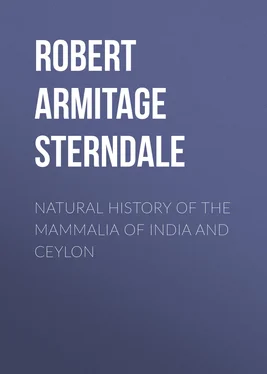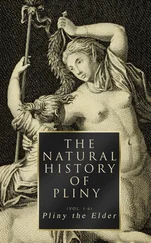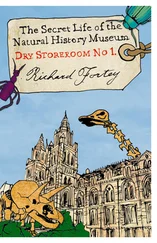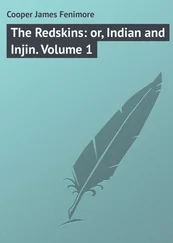Robert Armitage Sterndale - Natural History of the Mammalia of India and Ceylon
Здесь есть возможность читать онлайн «Robert Armitage Sterndale - Natural History of the Mammalia of India and Ceylon» — ознакомительный отрывок электронной книги совершенно бесплатно, а после прочтения отрывка купить полную версию. В некоторых случаях можно слушать аудио, скачать через торрент в формате fb2 и присутствует краткое содержание. Жанр: foreign_edu, Биология, на английском языке. Описание произведения, (предисловие) а так же отзывы посетителей доступны на портале библиотеки ЛибКат.
- Название:Natural History of the Mammalia of India and Ceylon
- Автор:
- Жанр:
- Год:неизвестен
- ISBN:нет данных
- Рейтинг книги:5 / 5. Голосов: 1
-
Избранное:Добавить в избранное
- Отзывы:
-
Ваша оценка:
- 100
- 1
- 2
- 3
- 4
- 5
Natural History of the Mammalia of India and Ceylon: краткое содержание, описание и аннотация
Предлагаем к чтению аннотацию, описание, краткое содержание или предисловие (зависит от того, что написал сам автор книги «Natural History of the Mammalia of India and Ceylon»). Если вы не нашли необходимую информацию о книге — напишите в комментариях, мы постараемся отыскать её.
Natural History of the Mammalia of India and Ceylon — читать онлайн ознакомительный отрывок
Ниже представлен текст книги, разбитый по страницам. Система сохранения места последней прочитанной страницы, позволяет с удобством читать онлайн бесплатно книгу «Natural History of the Mammalia of India and Ceylon», без необходимости каждый раз заново искать на чём Вы остановились. Поставьте закладку, и сможете в любой момент перейти на страницу, на которой закончили чтение.
Интервал:
Закладка:
SIZE.—Length of male, head and body 23 inches; tail, without hair, 8 inches; with hair 10 inches.
The above description is taken from Dr. Anderson's account, 'Anat. and Zool. Res.,' where at page 54 will be found a plate of the skull showing the powerful canine teeth. Blyth mentions a fine male with hair on the shoulders four to five inches long.
HABITAT.—Cachar, Kakhyen Hills, east of Bhamo.
DESCRIPTION.—Upper surface of head and along the back dark brown, almost blackish; sides and limbs dark brown; the hair, which is very long, is ringed with light yellowish and dark brown, darker still at the tips; face red; tail short and stumpy, little over an inch long.
This monkey is one over which many naturalists have argued; it is synonymous with Macacus speciosus , M. maurus , M. melanotus , and was thought to be with M. brunneus till Dr. Anderson placed the latter in a separate species on account of the non-annulation of its hair. It is essentially a denizen of the hills; it has been obtained in Cachar and in Upper Assam. Dr. Anderson got it in the Kakhyen Hills on the frontier of Yunnan, beyond which, he says, it spreads to the southeast to Cochin-China.
DESCRIPTION.—Head large and whiskered; form robust; tail stumpy and clad; general colour of the animal brown; whiskers greyish; face nude and flesh-coloured, with a deep crimson flush round the eyes.
SIZE.—Two feet 9 inches; tail about 3 inches.
This large monkey, though not belonging to British India, inhabiting, it is said, "the coldest and least accessible forests of Eastern Thibet," is mentioned here, as the exploration of that country by travellers from India is attracting attention.
Tail longer than in Inuus , and face not so lengthened; otherwise as in that genus.— Jerdon .
NATIVE NAMES.— Bandar , Hindi; Makadu or Wanur , Mahratti; Kerda mahr of the Ghâts; Munga , Canarese; Koti , Telegu; Vella munthi , Malabar.
HABITAT.—All over the southern parts of India, as far north as lat. 18°.

DESCRIPTION.—Of a dusky olive brown, paler and whitish underneath, ashy on outer sides of limbs; tail dusky brown above, whitish beneath; hairs on the crown of the head radiated.
SIZE.—Twenty inches; tail 15 inches.
Elliott remarks of this monkey that it inhabits not only the wildest jungles, but the most populous towns, and it is noted for its audacity in stealing fruit and grain from shops. Jerdon says: "It is the monkey most commonly found in menageries, and led about to show various tricks and feats of agility. It is certainly the most inquisitive and mischievous of its tribe, and its powers of mimicry are surpassed by none." It may be taught to turn a wheel regularly; it smokes tobacco without inconvenience.— Horsfield .
NATIVE NAME.— Rilawa , Singhalese.
HABITAT.—Ceylon and China.
DESCRIPTION.—Yellowish brown, with a slight shade of green in old specimens; in some the back is light chestnut brown; yellowish brown hairs on the crown of the head, radiating from the centre to the circumference; face flesh-coloured and beardless; ears, palms, soles, fingers, and toes blackish; irides reddish brown; callosities flesh-coloured; tail longish, terminating in short tuft.— Kellaart .
SIZE.—Head and body about 20 inches; tail 18 inches.
This is the Macacus sinicus of Cuvier, and is very similar to the last species. In Ceylon it takes the place of our rhesus monkey with the conjurors, who, according to Sir Emerson Tennent, "teach it to dance, and in their wanderings carry it from village to village, clad in a grotesque dress, to exhibit its lively performances." It also, like the last, smokes tobacco; and one that belonged to the captain of a tug steamer, in which I once went down from Calcutta to the Sandheads, not only smoked, but chewed tobacco. Kellaart says of it: "This monkey is a lively, spirited animal, but easily tamed; particularly fond of making grimaces, with which it invariably welcomes its master and friends. It is truly astonishing to see the large quantity of food it will cram down its cheek pouches for future mastication."
NATIVE NAME.— Kra , Malay.
HABITAT.—Tenasserim, Nicobars, Malay Archipelago.

DESCRIPTION.—"The leading features of this animal are its massive form, its large head closely set on the shoulders, its stout and rather short legs, its slender loins and heavy buttocks, its tail thick at the base" (Anderson). The general colour is similar to that of the Bengal rhesus monkey, but the skin of the chest and belly is bluish, the face livid, with a white area between the eyes and white eyelids. Hands and feet blackish.
SIZE.—About that of the Bengal rhesus.
According to Captain (now Sir Arthur) Phayre "these monkeys frequent the banks of salt-water creeks and devour shell-fish. In the cheek-pouch of the female were found the claws and body of a crab. There is not much on record concerning the habits of this monkey in its wild state beyond what is stated concerning its partiality for crabs, which can also, I believe, be said of the rhesus in the Bengal Sunderbunds."
HABITAT.—Burmah.
DESCRIPTION.—In all respects the same as the last, except that its face is blackish, with conspicuously white eyelids.
The Indian members of this family belong to the sub-family named by Geoffroy Nycticebinæ .
NATIVE NAME.— Sharmindi billi , Hindi.
HABITAT.—Eastern Bengal, Assam, Garo Hills, Sylhet, Arracan.— Horsfield .
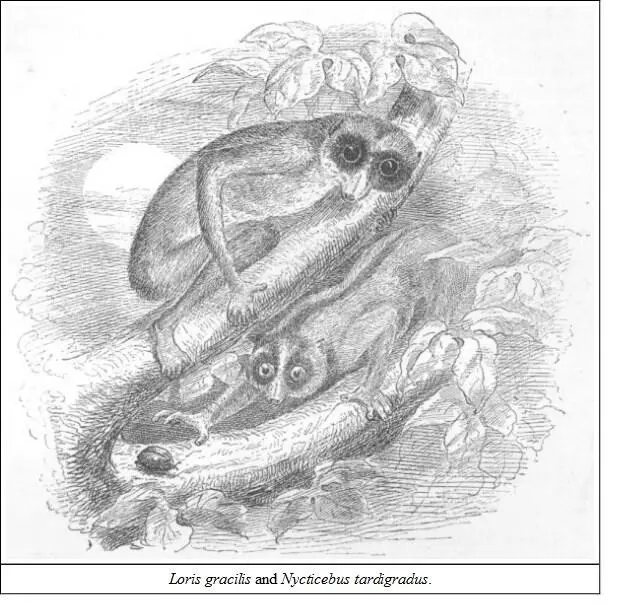
DESCRIPTION.—Dark ashy grey, with a darker band down middle of back, beneath lighter grey; forehead in some dark, with a narrow white stripe between the eyes, disappearing above them; ears and round the eye dark; tail very short.— Jerdon .
SIZE.—Length about 14 to 15 inches; tail 5/8 of an inch.
Nocturnal in its habits; sleeping during the day in holes of trees, and coming out to feed at night. Sir William Jones describes one kept by him for some time; it appeared to have been gentle, though at times petulant when disturbed; susceptible of cold; slept from sunrise to sunset rolled up like a hedgehog. Its food was chiefly plantains, and mangoes when in season. Peaches, mulberries, and guavas, it did not so much care for, but it was most eager after grasshoppers, which it devoured voraciously. It was very particular in the performance of its toilet, cleaning and licking its fur. Cuvier also notices this last peculiarity, and with regard to its diet says it eats small birds as well as insects. These animals are occasionally to be bought in the Calcutta market. A friend of mine had a pair which were a source of great amusement to his guests after dinner. (See Appendix C. Конец ознакомительного фрагмента. Текст предоставлен ООО «ЛитРес». Прочитайте эту книгу целиком, купив полную легальную версию на ЛитРес. Безопасно оплатить книгу можно банковской картой Visa, MasterCard, Maestro, со счета мобильного телефона, с платежного терминала, в салоне МТС или Связной, через PayPal, WebMoney, Яндекс.Деньги, QIWI Кошелек, бонусными картами или другим удобным Вам способом.
)
Интервал:
Закладка:
Похожие книги на «Natural History of the Mammalia of India and Ceylon»
Представляем Вашему вниманию похожие книги на «Natural History of the Mammalia of India and Ceylon» списком для выбора. Мы отобрали схожую по названию и смыслу литературу в надежде предоставить читателям больше вариантов отыскать новые, интересные, ещё непрочитанные произведения.
Обсуждение, отзывы о книге «Natural History of the Mammalia of India and Ceylon» и просто собственные мнения читателей. Оставьте ваши комментарии, напишите, что Вы думаете о произведении, его смысле или главных героях. Укажите что конкретно понравилось, а что нет, и почему Вы так считаете.
